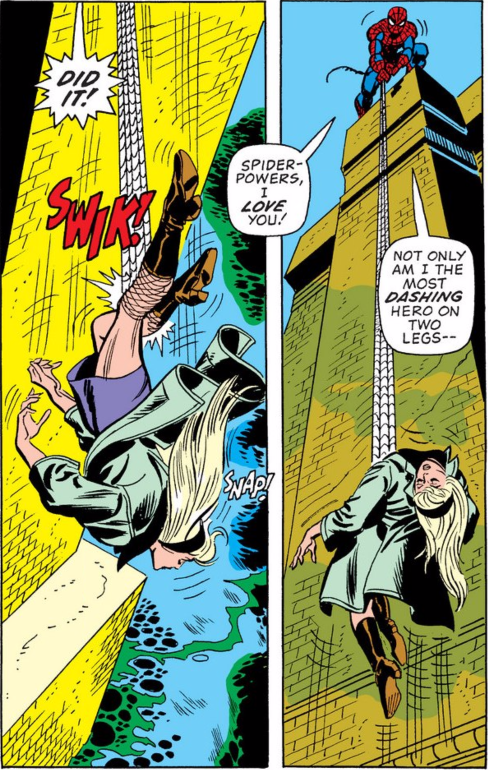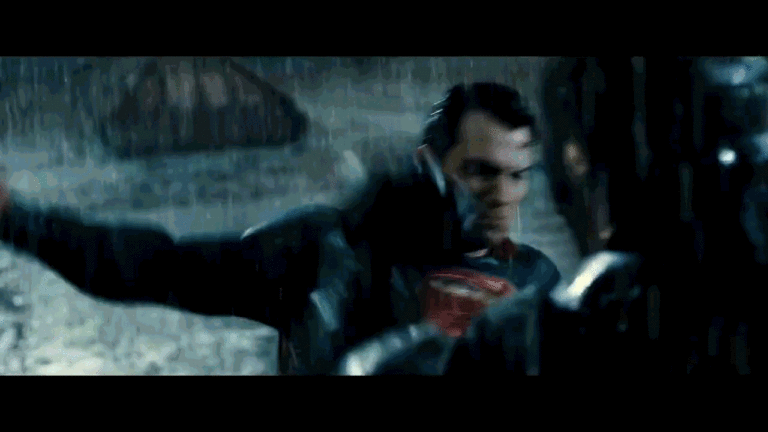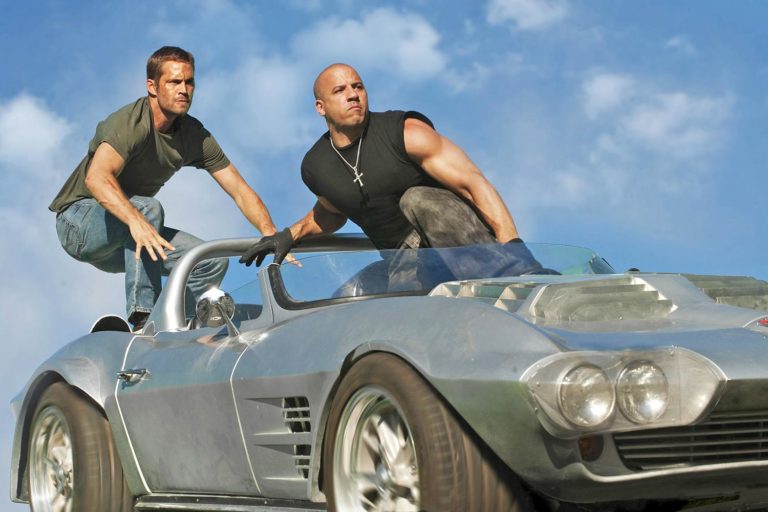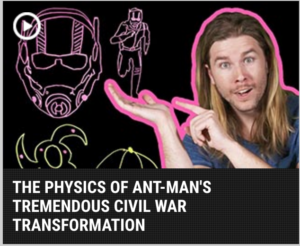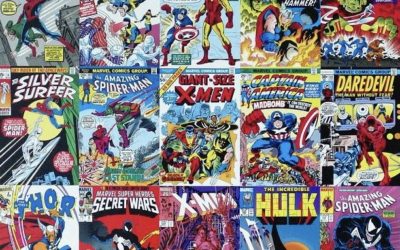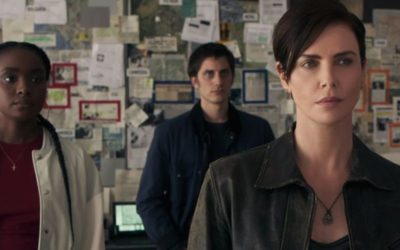We’re not saying that using popular culture science references and examples will get you higher scores, perfectly-behaved students and make you look ten years younger, but…well, it might.
Using pop culture in your science classroom is an easy way to increase student engagement while letting your own geek flag fly, which increases your enthusiasm for the subject and for helping your students understand it. Starting to use pop culture references in science is easy enough to get rolling, but there are some steps along the way that you need to follow to make sure you don’t end up with distracted students, and worse, misunderstanding your own lesson.
Let’s go through some of the basics.
The chief thing to remember in using pop culture as an example of science, or to engage students in science is the unbreakable rule: do not kill the fun.
As we’ve said many times on The Science Of, our aim here isn’t to rain on parades or explain why things can’t happen. Your mileage may vary, but as we see it, amazing feats of strength, agility and science-bending are metaphors. What’s visual shorthand to show how strong and fast Superman is? Have him fly out, circle the sun and fly back to sock Luthor in the face – really hard – thanks to the speed he picked up from a slingshot around the sun. All of that? A metaphor for Superman’s power. It’s the same for virtually every superhero or villain. Superpowers express just that – power. There’s no territory to be won in pointing out how these things can’t happen (Luthor’s head would vaporize in the example above). But there is territory to be won in using these cool things as a Trojan Horse to get into student’s (or any other audience) head and get them thinking about science.
Engagement is the key. Put a tasty panel from an Amazing Spider-Man on your screen, or a video clip from The Flash, and you’ve got them hooked. The visuals are cool, and your audience is interested. Now – use that interest to talk and teach science.
How do you go from liking pop culture to using it in your science classroom? We’ve got some ideas to help you out:
1) Use Current Pop Culture References that Your Students Know.
Let’s start with some hard reality that, as teachers, we all know, but don’t like to face. Through your students’ eyes: You’re old. Everything you like is uncool. If your references are more than ten years old, they’re not cool, and you suck.
Seriously. To your students, the original Star Wars trilogy is ancient history, and it looks like it too.
The more current the reference, the better. For example, I was using the Deadpool trailer in November of 2015 for the basis of a physics lab, when the movie didn’t come out until February of 2016. Look at trailers. Look at current movies, television shows, comic books, video games and YouTube videos. That’s the cultural language of your students. Don’t force them to learn your generation’s cultural language.
Like all rules, there are caveats. Classic images are…classic and will transcend the decades. For example – the death of Gwen Stacy in Amazing Spider-Man #121 as an example of momentum, impulse and force. Sure, the issue is over 40 years old, and the story has been done and re-done a time or two since, but there’s something about that art, that original color, and the emotion of it all that will still hook today’s students – speaking from personal experience.
You’ll never know unless you try – but safe to say, if the example you’re thinking of using is still referenced by today’s fans (comic fans to this day will get into arguments about Gwen Stacy’s fall), give it a try.
But generally, and especially if you’re just getting started at using pop culture in your classroom, go with what they’ll know on their own. It will give your students ownership in the problem, and help with engagement.
Once students get used to the idea of movies, comics, games and more making appearances, they’ll be open to older or “further afield” references that you bring to class.
2) Invest in the Pop Culture You’re Using.
If you’re going to use it, you need to know it. Period.
When I started this idea of working with movies, television and comics in class, I can’t say I was a fan of The Fast and the Furious movies. Today, I can’t say that I’m a fan, but I’ve seen them, I know the basics of the relationships and who the characters are. That way, when I show Brian’s car from the original movie (which technically is “uncool” because it came out 15 years ago) as an illustration of acceleration, I’m speaking from a place of…sort of…authority, and my students can feel that. I can speak intelligently about the other characters and plots of the movies through Furious 7 (they get a little more bearable when Dwayne Johnson joins the cast…just saying).
Additionally – it helps if your references match with your students. Sure, Batman vs. Superman: Dawn of Justice (which will be coming out on DVD next month, and has some great physics and physical science examples in it) is all big and flashy, but when I look out at my students in my Title 1 school, I see the cast of The Fast and the Furious, not the all-white heroes of Batman v. Superman. Your mileage may vary, of course. Learn to become culturally responsive to your students. Taking the time initially to find out who your students are and what they’re into will make your life easier in the long run as you try to find relevant examples to bring your lessons to life. If the material is not culturally relevant to them your class has just become another thing they will forget as soon as the bell rings. We’ve all seen it, they come to class everyday as if it is the first time they have ever been in there because to them it essentially is.
In short, your students will know if you actually like the clip you’re using, or are just faking it as an example that you think they’ll like. One way will get you engagement; the other will get side conversations and students not paying attention.
3) Don’t Bite Off More Than Your Students Can Chew.
Probably the most common newbie example is using way, way more of the movie, television show or comic book than you need for your example. Student engagement can turn on a dime and go right through the door to distraction if you show a clip of an interesting storyline before or after the example, or worse, show the entire episode or movie, and ask them to recall a single, or a handful of examples of science. These comics, movies and television shows are not made to teach science – they’re made to entertain and engage the audience on an emotional level. You’re asking for distraction and losing the point if you show more than just the clip you need. The current generation of teenagers have grown up on vines and Instagram so they’re attention spans are short to non-existent. You want them using that precious window of focus on the lesson and not the film or clip. Sure, students will fuss, but once the problem gets rolling, they’ll forget about wanting to see what happens next, and focus on figuring out if what they saw could have happened in the first place.
Going back to my example of Gwen Stacy’s death – for my class worksheet, I only used three panels from the comic itself. Yes, the death was a climax to a larger story told in the issue, but that wasn’t important to the physics that resulted in Gwen’s death. I wrote a very brief summary/introduction to the story and then my students were off to the races. Get them focused on what you need them focused on.
4) Simplify, Simplify, Simplify.
Virtually every example of science being used in pop culture is going to leave something out. That’s where you fill in the blanks so as not to frustrate your students You may or may not deal with an at-risk population but this is vital to not only engage them but to maintain that engagement. At-risk populations are used to struggling through and have learned how to navigate through with the least possible resistance and subsequently fall through the convenient cracks in your lesson plan. By scaffolding the information for them they get a taste of success and become hungry for more. Once they are hooked and invested the rest is easy-peazy.
A car drives off a cliff? Estimate the height and give it to your students if it’s needed for the problem they’re working on. Again, with the Gwen example, the height of the bridge was given, as was Gwen’s mass, and the time it took her to come to a full stop at the end of Spider-Man’s webbing. I didn’t need my students worrying about any of those things to figure out the force that Gwen experienced when she came to her final stop.
For a thermochemistry worksheet/problem – I asked my students to calculate how many Joules of heat energy would be needed to turn Marshmallow (Elsa’s ice monster in Frozen) into a cloud of superheated steam. It was a fairly simple problem, but I didn’t need them to be distracted by pointless estimations, so I gave them the starting temperature and the ending temperature, as well as Marshmallow’s mass.
Giving students the values or the time scale needed takes nothing away from the work, and also guarantees that they will come to the same (or similar) answer, making grading a lot easier.
5) Work it Through Yourself First!
This goes without saying, but I’m saying it anyway, especially combined with #6, below. Set your problem up, give the values needed, and then do the work. We all can fall in love with our creations. Put yourself in your students’ shoes and make sure the whole thing works with an easy flow, from start to finish. You don’t want to lose the value of the lesson or problem by making the example over-complicated, or, worst case, impossible.
And then, once you’ve worked it through, you’ve got your key ready to go.
6) Don’t Reinvent the Wheel.
Finally – even though you may just be starting to use pop culture in your science classes, you’re walking on a well-worn path. The physics of Gwen Stacy’s fall have been analyzed to death, perhaps most conclusively by James Kakalios in The Physics of Super-Heroes (Chapter 3). I worked from his examination of the problem to generate my worksheet and set-up the problem. Kakalios’ book is chock-ful of physics examples from comics (watch the age, though – Dr. Kakalios loves the Silver Age of comics, which can be a tough sell to teenagers) that can be easily transferred to the characters’ recent appearances in movies and on television.
Kyle Hill at The Nerdist produces “Because Science” videos that use popular culture (usually movies, but occasionally cartoons and comics) to talk about science, while Jake Roper at Vsauce3 on YouTube has a series of terrific videos looking into the science behind many pop culture characters and scenes – and those are just two of dozens of sites, books, articles and more that you can find on virtually any topic (although there’s a certain thrill when you’re the first to find an event/scene/character that can be “scienced”).
The trick with the sources you’ll find is that very few of them have been created or written with the classroom in mind (although Kyle Hill works to make sure all of his are classroom-ready) – so you’ll have to work through the example and pull out what you need, and turn say, a video or an article, into a solvable problem that helps your students to better understand a concept. The hive mind of the internet will focus on a particular movie or television show when it’s released, which will help you with your quest for current references. For example, there are a bunch of articles and videos about diversity, threatened species, octopi and biodiversity that use Finding Dory as their lead-in to talk science.
But there are lots and lots of “Science Of’s” out there (heck, we’re one! Hit us up if you’re stuck and need a fresh perspective on how to approach an old lesson) – start digging, and you’ll find lots of resources.
So what are you waiting for? You’ve got a huge cast of characters that your students know and love who are anxious to get into your classroom and start helping you teach science. Open that door and let them in.




